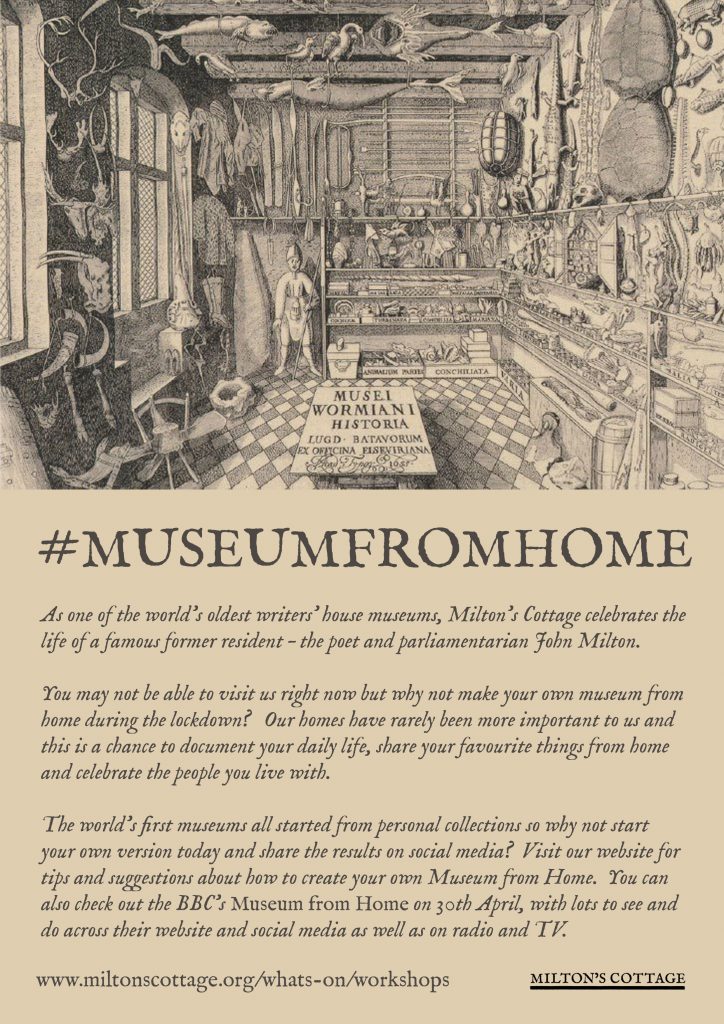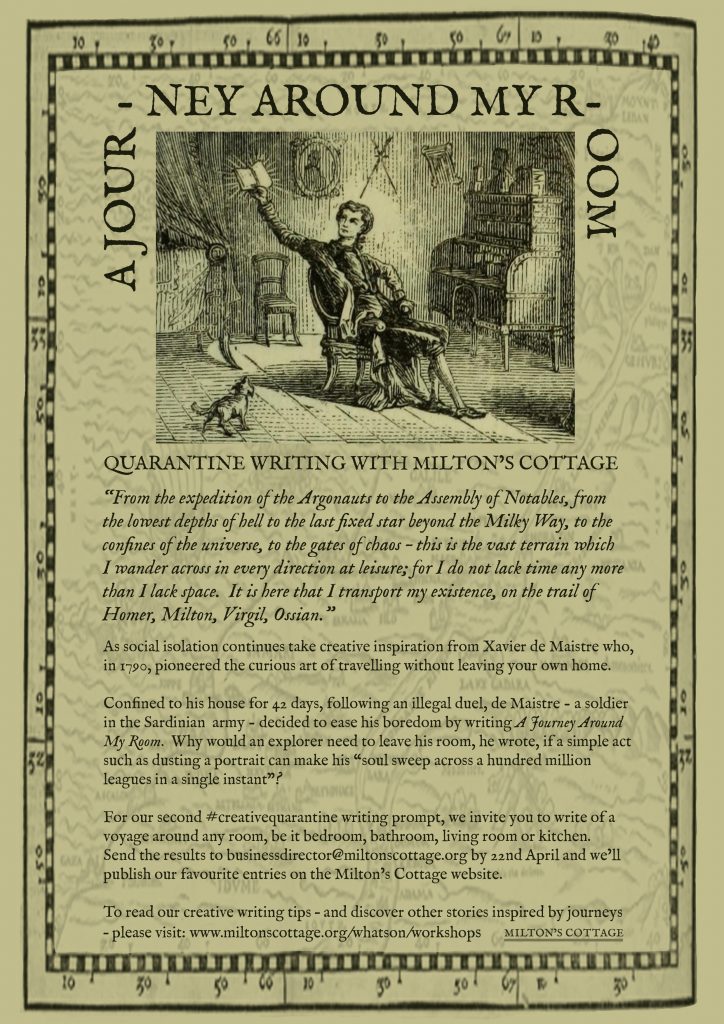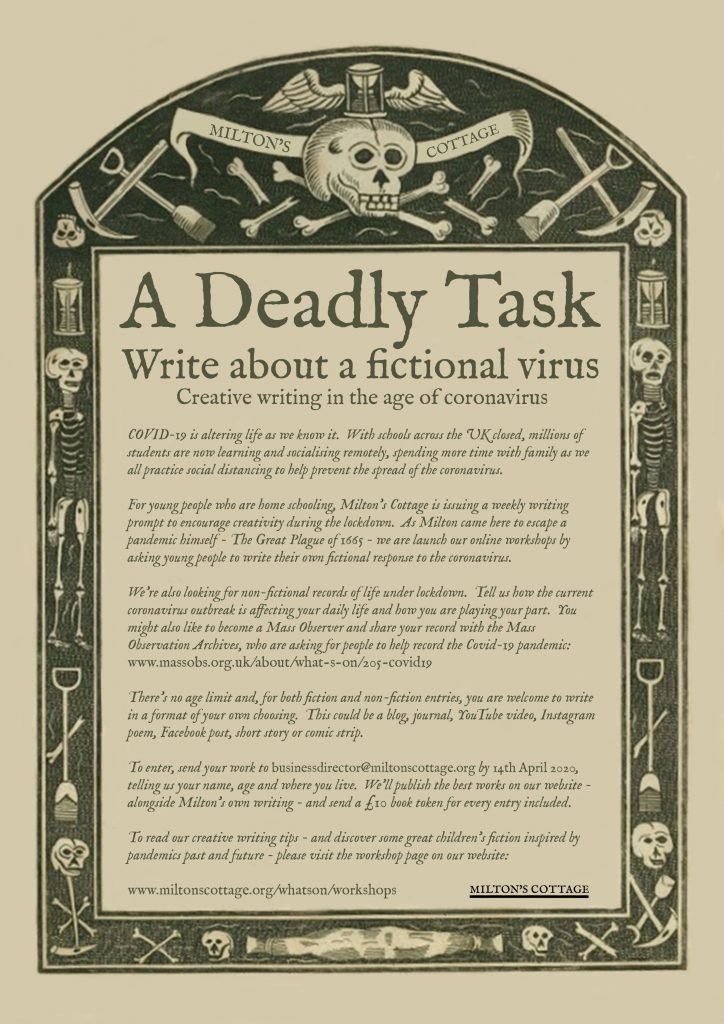
PARADISE LOST: shared reading group
3rd Tuesday of the month, starting on 16th January from 2pm
The Friends of Milton’s Cottage are running a monthly shared reading group at Milton’s Cottage.
Join them to read and discuss the 12 books of Paradise Lost over the 12 months of 2024. The next meeting, which covers Book 4, will take place on Tuesday 16th April from 2pm.
Everyone is welcome, and you will be invited to read as much or as little as you like from the poem, followed by an informal discussion of Milton’s epic masterpiece in the place where he completed it.
This shared reading group is free to join, with donations welcome to cover tea, coffee and cake. For further information, please contact Lynda Weiss on lyndaweiss@gmail.com
Animating Animals
Supported by The Clare Foundation, we hosted a family-friendly stop-motion animation workshop in our garden and museum this summer.

Online creative writing workshops
Museum from Home
As one of the world’s oldest writers’ house museums, Milton’s Cottage celebrates the life of a famous former resident – the poet and parliamentarian John Milton. You may not be able to visit us right now but why not make your own museum at home – about your own life and the people you’re living with during the lock-down? All you need is some pens, paper, imagination and the things you treasure at home. Here’s some simple steps to get you started:
1. Design your museum
Start by deciding where you are going to locate your museum. Is there a space in your home that you can dedicate to your own museum display? It could be:
- A shelf
- A cupboard
- A secret space hidden in your bedroom
- An area you’ve never paid much attention to before
- An area in a busier part of the home, such as the kitchen table or beside the TV
- A window or windowsill, so that passers-by can see it too
Don’t forget to ask for permission first if you’re planning on using a shared part of your house.
2. Select artefacts for your museum
Your museum will need artefacts, or objects of historical interest. This could be things you love, items you find (don’t forget to ask permission before adding them to your collection) or objects and images you’ve created specially. Here’s some ideas to get you started:
- A portrait of yourself (this could be a photo, a drawing or a description in words)
- Pictures of your friends and family
- Images, floor plans and diagrams of your house
- Holiday souvenirs
- Some much-loved toys
- An outfit you wore on a special occasion
- Your favourite book
3. Curate your museum displays
Museums have displays on walls and use shelves and display cases filled with drawers of interesting things. Some have digital displays using computers and tablets. Think about how you can group your artefacts in different ways to make them interesting and eye-catching for your visitors. This could be in date order, by theme or by colour. You don’t have to limit yourself to one room, either. Your soft toy collection could be a natural history exhibit while the bathroom could become an aquarium.
4. Label your exhibits
Why not create labels for your artefacts and give them fun titles? You can display these next to each item. Include the name of each item in your collection and any other relevant information, such as when it was made, where it was found, what its function is. Your labels can be serious or silly, fascinating or fake. This is your museum and you set the rules.
5. Think about the visitor experience
Prepare for your opening day! If you have visited a museum recently, try to remember what your found most enjoyable about the experience. Think about how visitors to your museum (your family and friends) will engage with your exhibits, whether live or virtually from afar.
- Will you greet them and give them a tour?
- How about recording a museum talk and sharing it online?
- Can you create a treasure hunt to lead your visitors through the museum?
- Would you like a shop where you can sell or give away museum souvenirs, such as postcards that you’ve made?
- Could you make a poser to promote your museum to friends and family?
6. Document your museum
Why not ask your mum, dad, carer or guardian to help you take some photos or a video to create a lasting document of your museum and what it’s all about? If you’d like to share your documentation with others via the Milton’s Cottage website you can include send it to businessdirector@miltonscottage.org or use our social media handle @MiltonsCottage. We’ll give a free tour of Milton’s Cottage to you and an accompanying adult for every image we publish.

Journey Around Your Room: a travel writing challenge.
“The mind is its own place, and in it self / Can make a Heav’n of Hell, a Hell of Heav’n.”
Paradise Lost, Book I, lines 233-234
Books have the power to take us on many kinds of journeys. From The Lion, The Witch and The Wardrobe to When Hitler Stole Pink Rabbit, many of the most enduring children’s books transform something ordinary – a wardrobe, a soft toy, a bobbin – into vehicles for exhilarating journeys.
Taking inspiration from Xavier De Maistre – who pioneered the art of travelling without leaving home – this week’s creative writing challenge invites you to describe a voyage around your own home.
If you’re looking for inspiration, you might enjoy the following books – many of which were written by self-confessed fans of Milton. Whether in space, at sea, or the centre of the earth they all take readers on journeys so transporting it’s a pleasure to get lost.
The Arrival by Shaun Tan:
Feel what it’s like to travel to a strange new land in this migrant’s story told as a series of wordless images.
The Borrowers by Mary Norton:
A secret family of four-inch people live in the secret places of quiet old houses – and go on frequent ‘borrowing’ expeditions.
Esperanza Rising by Pam Muñoz Ryan: Esperanza and her mother flee their privileged lives in Mexico and find refuge in the migrant camps of Southern California during the Great Depression.
The Graveyard Book by Neil Gaiman: Brought up by the Dead, Bod is hunted by an assassin, befriends a murdered witch, and prepares himself for life beyond the burying ground.
Haroun and the Sea of Stories by Salman Rushdie: On the back of the Hoopie bird, Haroun flies to the Sea of Stories to find the storyteller’s gift for his father, who has run out of stories.
His Dark Materials trilogy by Philip Pullman: Follow Lyra and Will as they embark on a multi-universe odyssey that takes in armoured bears, aeronauts, witches, daemons and more.
The Hobbit, or There and Back Again by J.R.R. Tolkien: A rich imaginative tale of dragons, dwarves and the ageless search for gold. Rooted in authentic Saxon lore, but written and illustrated with humor and charm.
Journey to the Centre of the Earth by Jules Vern: Professor Otto Lidenbrock and his nephew set off through an Icelandic volcano to try and find the volcanic tubes they believe lead to the centre of the earth.
The Lion, the Witch and the Wardrobe by C.S. Lewis: The old theme of good against evil is restated in a tale that creates its own world of magic.
The Little Prince by Antoine de Saint-Exupéry: An allegorical tale of a stranded pilot and a boy from beyond the stars. “One sees clearly only with the heart.”
The Phantom Tollbooth by Norton Juster:
Complaining of boredom, Milo travels through a tollbooth to a ridiculous land where Rhyme and Reason are lost.
Watership Down by Richard Adams: Follow the rabbits of Sandleford Warren as a group of them, convinced danger is on its way, set off to try and find a new home.
When Hitler Stole Pink Rabbit by Judith Kerr: The unforgettable – and semi-autobiographical – story of one Jewish family’s flight from Nazi Germany.
Where the Wild Things Are by Maurice Sendak:
Sometimes, when you’re having a bad day, you need to travel to a place where you can be a monster.
A Wrinkle in Time by Madeleine L’Engle: Three children cross time and space to rescue Meg’s father from the evil, pulsating It.

A Deadly Task: write about a fictional virus
To start, it seems only fitting to ask young people to writer their own fictional record of this unprecedented situation: how the coronavirus outbreak is affecting their daily lives, how can we all play our part during the crisis and what stories the term “social distancing” conjures up for them.
We’re also looking for non-fiction entries. Keep a record of your life in these unprecedented days, in a form of your own choosing. This could be a journal, blog, YouTube video, Instagram poem, Facebook post, short story, comic book or haiku. We’ll present the best works on our website as a collective record of living through the coronavirus crisis.
You might also like to become a Mass Observer and share your record with the Mass Observation Archives, who are asking for people to help record the Covid-19 pandemic:
https://www.massobs.org.uk/about/what-s-on/205-covid19
Top tips for fiction writers
- Keep your writing and composing close by, so you can jot things down to return to them later. Note down a few words, here and there, and then compose in full sentences
- How can you make your fictional virus real to your readers? What are the symptoms – and the effects? Who is most likely to be affected: does it affect everyone equally or are some people more likely to catch it than others?
- Is your fictional virus caught in the past, present or future?
- If the latter – what else has changed in your fictitious future world? Have these changes helped create the ideal conditions for your virus? Is the virus happening in real time during your narrative or are you looking back to an earlier outbreak – perhaps the one we’re living through now? Perhaps think of your children, or grandchildren, who might one day ask you what was it like for you during the 2020 coronvirus pandemic
- If your work is set in the past, it might be helpful to research earlier pandemics for inspiration. Did you know that Milton came to Chalfont St Giles in 1665 to escape one of London’s worst ever outbreaks of plague? Or that President Ford, faced with exactly one swine flu death, ordered the mass vaccination of Americans in 1976?
- Who is the lead character in your fiction? Is it you – writing in the first person – or are you writing about someone else? Think about the role of the individual as they face your fictional virus and how they react to it. What can you tell us about their relationship to others – to family, friends, and society at large?
- When you think about society, think about parts of it: Wuhan province, Italy, the stock market, online classes, isolation, your town, your family, hospitals, politicians, health insurance, selfishness, fear, sick leave, economic policies, exponential expansion, individualism, cooperation, competition, solidarity … and more
- If you read an article or post that you find interesting, you might like to include a link in your own work and write a few brief reflections
- Why not include images from social media or your own photos?
Journal writing tips
Tip #1 – Silence your inner critic
It’s your journal and your words and it’s up to you how you write them down. However you decide to approach your journal, it is valuable – NO MATTER WHAT – because it is yours and yours alone.
Tip #2 – Break the rules
You can break all the rules of grammar and spelling (or follow them if you prefer). Either way, it’s your choice and there’s no such thing as right or wrong when writing a journal.
Tip #3 – Go with the flow
Take some time and tune in to how you feel. Do you feel like writing a lot or just one perfectly chosen word to sum up your entire day? Go with the flow and let your writing come easily and naturally so it expresses you!
Tip #4 – Pick a special writing spot
Some people can write anywhere. Others like to pick a special place where they feel safe, comfortable and inspired – so they can lose themselves in their journal writing.
Tip #5 – Go wild with words – and pictures
Use stickers, coloured pens, magazine pictures, drawings, or photos to jazz up your journal. Keeping things creative and colourful will make your writing experience more exciting and memorable.
Tip #6 – Keep it simple
If your journal writing begins to feel like a task you must accomplish, it might be time to take a break or scale back on the length of your entry. Remember that your journal writing experience is always more enjoyable when it feels spontaneous.
Tip #7 – Discover your own style
Ask yourself if you like to use only words (no pictures or stickers) or if you prefer to combine writing and drawing. Maybe poetry dominates your journal or maybe your preference is to break all the rules and simply free write.
Tip #8 – Create a themed journal
You can create a dream journal, a wish journal, or a journal of family, friends, and best moments in life. Be creative in choosing themes and if you run out of ideas you can always research new journal writing ideas online.
Tip #9 – Rule your Queendom/Kingdom
Celebrate, vent, accentuate, complain… it’s up to you what goes on to your journal pages. Please remember though to always, always, be kind to yourself (because cruelty hurts and makes you sad).
Tip #10 – Keep it fun and fulfilling
If it’s not fun and fulfilling, chances are you’ll quit writing. So jazz up your journal by giving yourself permission to try new journaling techniques. AND keep it fulfilling by focusing on a wide range of topics (not just sad or bad ones, but happy and exhilarating ones as well).
Journaling tips summary
All the journal writing tips in the world can only guide you, and, in the end, you must choose your style based on what works best for you.
Daily journal writing is a wonderful tool of expression for preteens and teens but they must feel invested in their writing. The best way to get them – and to keep them – invested is to encourage the free expression of their uniqueness and creativity.
Let them choose the journal writing style that best suits their personality and unique tastes and you are guaranteed that they WILL start (and continue) journaling!
Until next time, write on…
Why write a journal?
They can help us when we’re anxious
When we write about what is happening to us it can sometimes make it easier to make sense of things.
If we find we are frequently writing about a particular situation which is making us unhappy that’s a clue that perhaps we need some help.
Feelings can be complicated but writing them down can help us unpick some of the “knots”.
They can keep a secret
Sshhh! You can tell your journal anything and it won’t tell – although you may want to get a lockable version if you do want to keep it private!
They can capture special times
If you re-read your diaries from when you were smaller you might be reminded about a much-loved family pet, an amazing Christmas or a brilliant holiday. Before you know it, you’ll be back on the beach in no time!
Remembering happy occasions can help us see that life isn’t always so bad, feel more hopeful about what’s to come. If you write down funny things that have happened, and good jokes you’ve learned, you can give your future self a good giggle!
They are a gift to ourselves
Imagine being an old lady or old man, reading back your diary entries from when you were a young girl or boy. I bet your future self will find it interesting.
It will remind you of what you were like when you were younger, who your friends were and what family life was like.
You might share it with your own children – or even your grandchildren and great-grandchildren – who might be surprised to learn you were a skateboarding star or the class clown.
They can be digital
You might think you’re not interested in diaries but if you’re old enough, it’s possible you like reading blogs, or watching vlogs. Sharing experiences in this way can look like fun, and a way to connect and help and entertain other people, but, remember you shouldn’t post any personal information online – and you can’t keep something secret if you have millions of subscribers! (It’s much safer to share your thoughts with a private page in a book).
CREATING A JOURNAL
What you’ll need:
Something to write in
- Notebooks come in all sorts of designs so you can choose one that suits your personality. Maybe you prefer something pocket sized – or if you love to write choose a big one with lots of pages!
- You can buy Diaries which have a page for each day. Some have a padlock to keep your secrets safe.
- Maybe you prefer to write a Digital Diary – using an app on your tablet, laptop, PC, or even your mobile phone! (Check with a grown up before you use new apps).
- If you fancy a larger space in which to get creative, why not opt for a Scrapbook? – Especially if you want to make a super dazzling diary with mementoes included.
Something to write with
- Pens and Pencils – black or blue or any colour you like!
- Maybe you enjoy writing with a posh fountain pen with purple ink, or perhaps you’re happier with a cheap and cheerful pencil with an eraser on so you can make changes to what you’ve written.
Things to jazz up your journal
- Coloured pens or pencils
- Stickers and stamps
- Photographs of people you like
- Postcards from places you have visited
- Souvenirs from days out – tickets, programmes, wristbands etc
- Interesting things you’ve found – e.g. leaves, flowers and newspaper cuttings
- Glue or tape to keep your treasures secure
